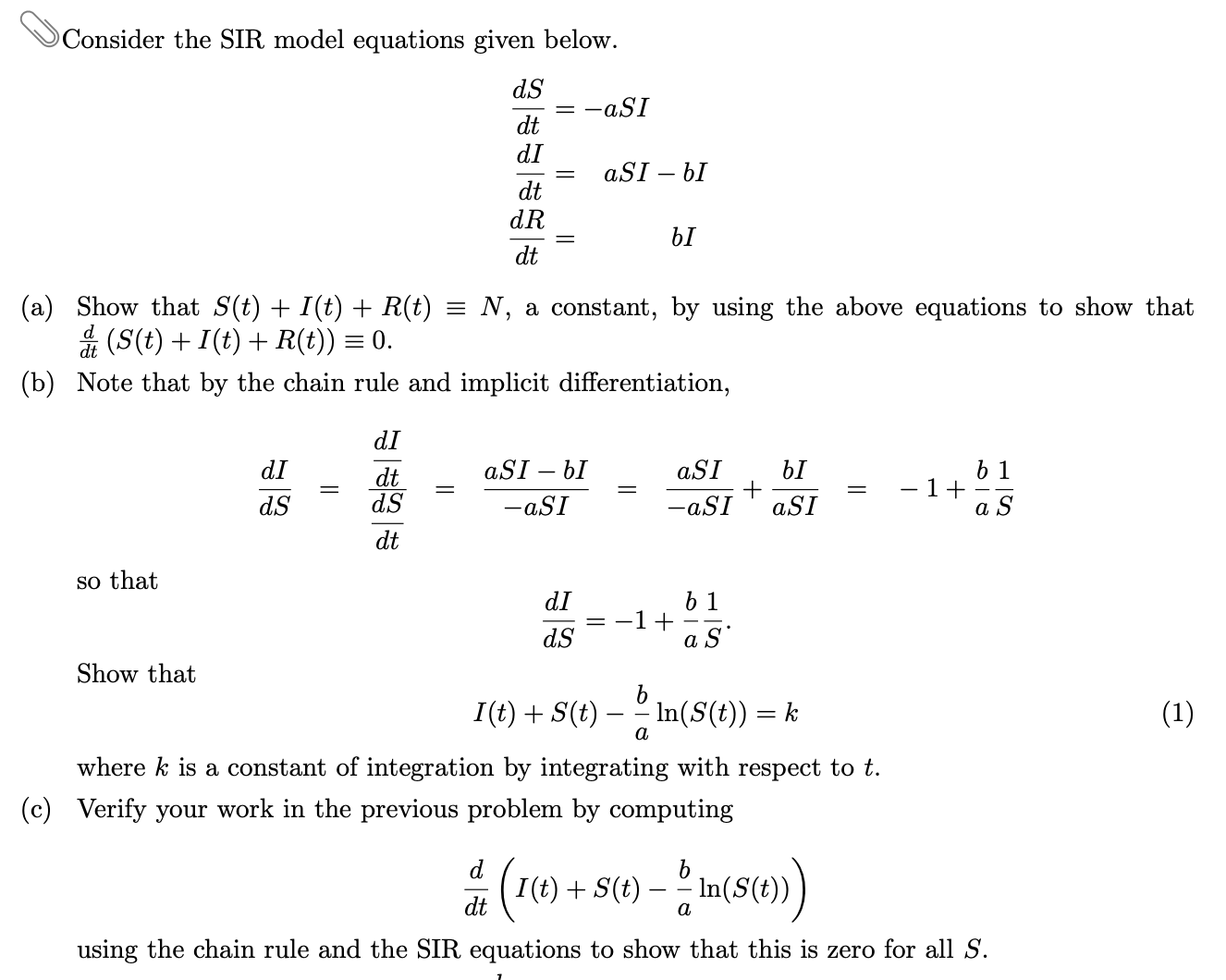OConsider the SIR model equations given below. dS -aSI dt dI aSI – bI dt dR bỊ dt (a) Show that S(t) +I(t) + R(t) = N, a constant, by using the above equations to show that i (S(t) + I(t) + R(t)) = 0. (b) Note that by the chain rule and implicit differentiation, dI b 1 -1+ a S dI aSI – bI aSI bI dt dS + aSI -aSI dS -aSI dt so that b 1 -1+ a S dI dS Show that I(t) + S(t) – ° In(S(t)) = k (1) a where k is a constant of integration by integrating with respect to t. (c) Verify your work in the previous problem by computing (1) + s() - m(5() d In(S(t)) dt a using the chain rule and the SIR equations to show that this is zero for all S. ||
OConsider the SIR model equations given below. dS -aSI dt dI aSI – bI dt dR bỊ dt (a) Show that S(t) +I(t) + R(t) = N, a constant, by using the above equations to show that i (S(t) + I(t) + R(t)) = 0. (b) Note that by the chain rule and implicit differentiation, dI b 1 -1+ a S dI aSI – bI aSI bI dt dS + aSI -aSI dS -aSI dt so that b 1 -1+ a S dI dS Show that I(t) + S(t) – ° In(S(t)) = k (1) a where k is a constant of integration by integrating with respect to t. (c) Verify your work in the previous problem by computing (1) + s() - m(5() d In(S(t)) dt a using the chain rule and the SIR equations to show that this is zero for all S. ||
Algebra & Trigonometry with Analytic Geometry
13th Edition
ISBN:9781133382119
Author:Swokowski
Publisher:Swokowski
Chapter9: Systems Of Equations And Inequalities
Section9.1: Systems Of Equations
Problem 50E
Related questions
Question
letter C

Transcribed Image Text:OConsider the SIR model equations given below.
dS
-aSI
dt
dI
aSI – bI
dt
dR
bỊ
dt
(a) Show that S(t) +I(t) + R(t) = N, a constant, by using the above equations to show that
i (S(t) + I(t) + R(t)) = 0.
(b) Note that by the chain rule and implicit differentiation,
dI
b 1
-1+
a S
dI
aSI – bI
aSI
bI
dt
dS
+
aSI
-aSI
dS
-aSI
dt
so that
b 1
-1+
a S
dI
dS
Show that
I(t) + S(t) – ° In(S(t)) = k
(1)
a
where k is a constant of integration by integrating with respect to t.
(c) Verify your work in the previous problem by computing
(1) + s() - m(5()
d
In(S(t))
dt
a
using the chain rule and the SIR equations to show that this is zero for all S.
||
Expert Solution
This question has been solved!
Explore an expertly crafted, step-by-step solution for a thorough understanding of key concepts.
This is a popular solution!
Trending now
This is a popular solution!
Step by step
Solved in 3 steps with 3 images

Knowledge Booster
Learn more about
Need a deep-dive on the concept behind this application? Look no further. Learn more about this topic, calculus and related others by exploring similar questions and additional content below.Recommended textbooks for you

Algebra & Trigonometry with Analytic Geometry
Algebra
ISBN:
9781133382119
Author:
Swokowski
Publisher:
Cengage

Functions and Change: A Modeling Approach to Coll…
Algebra
ISBN:
9781337111348
Author:
Bruce Crauder, Benny Evans, Alan Noell
Publisher:
Cengage Learning

Elementary Linear Algebra (MindTap Course List)
Algebra
ISBN:
9781305658004
Author:
Ron Larson
Publisher:
Cengage Learning

Algebra & Trigonometry with Analytic Geometry
Algebra
ISBN:
9781133382119
Author:
Swokowski
Publisher:
Cengage

Functions and Change: A Modeling Approach to Coll…
Algebra
ISBN:
9781337111348
Author:
Bruce Crauder, Benny Evans, Alan Noell
Publisher:
Cengage Learning

Elementary Linear Algebra (MindTap Course List)
Algebra
ISBN:
9781305658004
Author:
Ron Larson
Publisher:
Cengage Learning